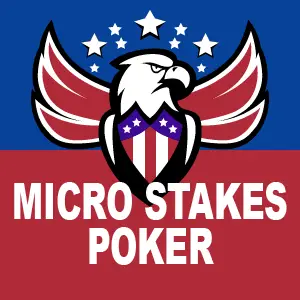Fast Track To Success – Lesson 1

Micro Stakes Poker (1)
- Most players have a preconceived notion of what type of player they want to be
- The style of your opponents always should dictate your strategy
- This involves both figuring out what they do and figuring out what to do back
Beating The Micro Stakes Isn’t As Hard As You May Think
In this series I’m looking to take people from zero to hero in as quick a period of time as possible. So in the first session we spoke about playing the lowest stakes a poker site as to offer so that you can give yourself the best chance of winning. So now in the upcoming sessions I’m going to give you some quick tips to get you hitting the ground running so to speak.
You need to keep in mind though that this is all designed just to get you to beat the micro stakes, which isn’t really that big of a deal in spite of what you may think. Micro stakes games are full of bad players, or at least they typically are, and if you’re not seeing that well perhaps you’re playing at the wrong poker site. However I’m going to set you up so you can beat the players at these games at even the toughest ones.
After you’ve finished this series, I strongly recommend that you move on to my main strategy series here, Ken’s Guide To Winning Poker, which will take you far beyond anything we’ll be talking about in this series. I’ll be just covering the basics in this one, things you will need to know and need to be thinking about in order to do well at these games. Even so though, this won’t be like any other beginners material you will ever have read.
What Kind Of Player Do You Want To Be?

So let’s start out by looking at how most beginners approach the game, and see how we can take this not only look to rebuild it, but also gain some insight into what our opponents are probably going to be like. The first thing a poker player goes through is a need to identify himself or herself. You’ve probably heard the terms aggressive, passive, tight, and loose, with all the combinations that emerge.
It used to be that most players, especially at the lower stakes, were loose, very loose in a lot of cases, and the way to play most effectively against them was to play tighter than they did. So all you’d really need to do was to look to show down better hands against them and you’d have a positive expectation, and usually a pretty big one.
So people started thinking about what kind of player they wanted to be, in a way that people choose a profession. So they would see players that were doing well and these players tended to be what we’d call tight aggressive and they wanted to emulate them. Other people would theorize that this was the best player type to be, and through all of this, over time tight became right, and aggressive always was considered to be right, so its popularity really took off.
So What’s The Best Type Of Player To Become?
So perhaps you’re expecting me to say, well, you want to be known as a tight aggressive player as well. So it might surprise you to know that this is completely the stuff of fools. There is no preset strategy that is preferable over another form, and any time you look to play a certain way as a means of your identity as a poker player, you are making a big mistake. Now it may turn out that, most of the time, against the players you tend to play against, being tight aggressive will be correct. The difference though is that this isn’t because it’s right in itself, it’s only because due to the way your opponents play, it’s what tends to work best in these situations.
In reality though, it’s correct to be tight aggressive far less often these days than it used to be, due to the fact that so many people play tight. What you want to be thinking about here is that any poker strategy or technique is exploitable, regardless of what it is, and our goal needs to be to account for the type of play that our opponents make, and come up with the right way to take advantage of it.
Good Poker Always Involves Countering Your Opponents’ Play
So poker is really a game of counter strategies, and our success will be measured by how well we adapt to what our opponents are doing. So what we’re after is to take what an opponent is doing the most of, what they do too much, and then look to take advantage of that. In the case of tight aggressive opponents, they fold too much and they also bet and raise too much. This is by definition actually.
So how is it that I can say that they are doing both of these things too much? Well if you’re that kind of player, you’re folding most of the time when you don’t need a hand, so I don’t need one to take a lot of pots away from you. This is because you are tight, and I’m using the correct counter strategy to that, which is to be more aggressive against you. There will be plenty of cases where you do have something and you don’t fold, but given that you fold as much as you do, it’s likely that I can make enough of a profit from the times you fold that it doesn’t even matter what cards I have.
Don’t Just Necessarily Do The Opposite Of What They Do
A lot of newer players think that if someone is playing tight then the counter strategy would be the opposite thing, which would be to loosen up, but that’s not the case. You have to think about what would best take advantage of a certain tendency, and there’s no question that if a player is tight, it means he or she folds a lot, and if we want them to fold, we need to bet or raise. So this means more aggressive, although it’s a looser form of aggression than they are playing.
They are playing few hands and playing them strongly, which is the definition of tight aggression. They may mix in some bluffs, but for the most part they, at some point in the hand at least, will have had a hand. Now what can happen is that they may continue with this aggression if they miss, for instance if they had a good hand pre-flop, miss the flop, and then decide to bet out anyway hoping that we’ll have missed as well and will give up on the hand.
So now, we’ll be looking to see how often they do that, and this is one of the ways we can exploit their other tendency, which is to be too aggressive at times. So if an opponent always fires out a continuation bet, which means that he or she was the pre-flop raiser or re-raiser, in other words putting in the last raise pre-flop, and then continues to lead the betting, then we’ll be looking to continue on ourselves with better hands than they have on average, and punish them this way as well.
It’s Not That Difficult To Come Up With A Good Plan Here
We don’t even need that strong of a hand to do this with in fact, as if they are betting out every time or almost every time, then most of the time they will have nothing, not even a pair. You only hit a pair on the flop on average one out of three times, so if we have one, and he bets out all the time, we will have a better hand two out of three times, and that’s way more than enough for us to play on.
The mistake a lot of players make here is to think that they need a lot better hand than they do. So say for instance you have second pair, and he bets, you’re thinking maybe your hand is no good, and you may end up throwing it away. You may be thinking, well the only thing I can really beat is a bluff, but you don’t realize that in a case like this the player is bluffing most of the time, and in fact he has to be given that he’s firing off these bets most of the time or even every time.
So What You Have Is Always Relative To What They Probably Have
So there’s two cases where we are going to look to exploit this player, and none of it has anything to do with how we identify ourselves as a poker player, meaning being one certain type or another. If we need to come up with such a category, we can define ourselves as being predators, preying on the tendencies of others and the need to have these primary tendencies. No matter what these tendencies may be, we want to prepare ourselves as best we can to counter them.
As we get better at this, we will become better players. It’s as simple as that. At the higher stakes and skill levels, our opponents will be better at coming up with counter strategies of their own, but we’re talking stakes well above the micro stakes. Players at these low stakes are stuck in their own identities. Many of them won’t even know what to do against your counter play, and those who do adjust won’t be ready at all for our own re-adjusting that we have planned in case this happens.
So this needs to be our primary focus when looking to learn the game, as we want to make sure that we learn the right things, and this is indeed the right thing and is fundamental to becoming a good player. Players don’t learn this until much later, after much more experience, and working themselves up much higher. So if you make being a predator your fundamental focus starting out at the micro stakes, you’ll really be taking a big step toward setting yourself up for success and developing your game to where you can move up the ladder pretty quickly.
Micro Stakes Poker – Fast Track to Success
- Fast Track To Success – Lesson 1
- Fast Track To Success – Lesson 2
- Fast Track To Success – Lesson 3
- Fast Track To Success – Lesson 4
- Fast Track To Success – Lesson 5
- Fast Track To Success – Lesson 6
- Fast Track To Success – Lesson 7
- Fast Track To Success – Lesson 8
- Fast Track To Success – Lesson 9
- Fast Track To Success – Lesson 10
- Fast Track To Success – Lesson 11
- Fast Track To Success – Lesson 12